“Double-flowered” refers to the flower species with extra petals, often containing a flower within a flower. Because of how difficult they are to cultivate and find, double blossoms have been prized and cherished since ancient times.
If you look closely, you will probably be able to identify a double blossom, but you might be curious as to how they originate. This article will provide you with all the information available on these unusual, intriguing, and divisive flowers.

A double rose can have 17 to 25 petals.
©Jen Wolf/Shutterstock.com
What are Double Bloom Flowers?
Double-bloom flowers have a rich history that dates back more than 2000 years. Ancient civilizations viewed them as a novelty and a symbol of prosperity.
These strange flowers have more petals than a single flower does. For example, a double rose can have 17 to 25 petals. There are also semi-double flowers, with several petals between simple and double.
Growing double flowers requires extra care and attention compared to growing single flowers. They need a lot of sunshine, well-draining soil, frequent fertilizing, and watering.

One of the most widespread cultivars is Dahlia variabilis, which can grow large, up to a 12-inch diameter.
©Olga Vasilek/Shutterstock.com
What Causes Double Bloom Flowers?
The cause of these flowers’ breeding problems and their explanation was a mystery for thousands of years. But now, modern genetic research has made it easier for us to understand why some flowers have multi-petals.
According to research, a faulty gene expression in the flower’s genes results in double flowers. The stamens, carpels, and sepals, all essential parts of the flower’s sex organs, are formed by proteins encoded by genes.
If the genes that regulate these break, they can’t produce the protein necessary to develop sexual organs. The male and female organ layers present in most flowers are absent, and they instead generate asexual petals.
Because they lack pollen, double-flowered plants typically stay open longer than single flowers. It’s like they’re waiting for pollinators that won’t show up.
The showiness of the double petals, plus the longer flowering time, has made these mutants very desirable. Nonetheless, many environmentalists are against them since they don’t feed local bees and pollinators.
Types of Double Bloom Flowers
Double blooms can be an exciting addition to your garden or greenhouse. If you are considering acquiring this flowering plant for your home, here is a list of the most popular species.
Roses
Roses (Rosa rubiginosa) are the most popular form of double-flowers. They have a beautiful and lush appearance and come in many colors, including pink, red, white, and yellow.
Growing double roses requires careful attention to soil, light, water, and fertilizer. They enjoy full sun or light shade and do best in rich, well-drained soil with a pH of 6.0 to 6.5. Depending on the weather and the soil’s moisture content, they should receive deep watering once or twice a week.
Double roses can grow in various USDA hardiness zones, depending on the variety. However, most double roses prefer to grow in zones 5 to 9, characterized by mild to moderate winters with minimum temperatures.
Double roses are susceptible to pests and diseases, including aphids, spider mites, blackspots, and powdery mildew, much like all other varieties of roses. Therefore, you should check on them regularly.
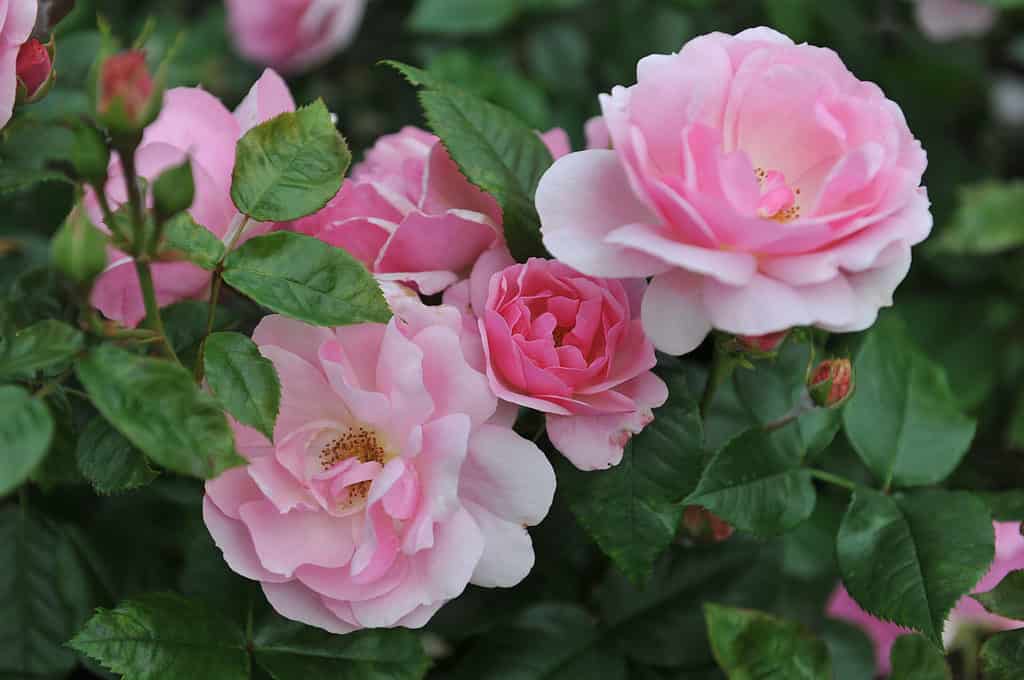
Roses (
Rosa rubiginosa) are the most popular form of double-flowers.
©Sergey V Kalyakin/Shutterstock.com
Peonies
The additional petals of double peonies give them a full, fluffy, and luxuriant look similar to a pom pom. One of the most widespread varieties is Paeonia lactiflora, which produces several cultivars such as ‘Bowl of cream’ and ‘Kansas.’
Double peonies typically bloom in the late spring or early summer, depending on the growing conditions. They usually bloom relatively quickly, typically lasting just a few weeks each year.
They mostly need well-draining soil with a pH between 6.0 and 7.0 and at least 6 hours of direct sunlight.
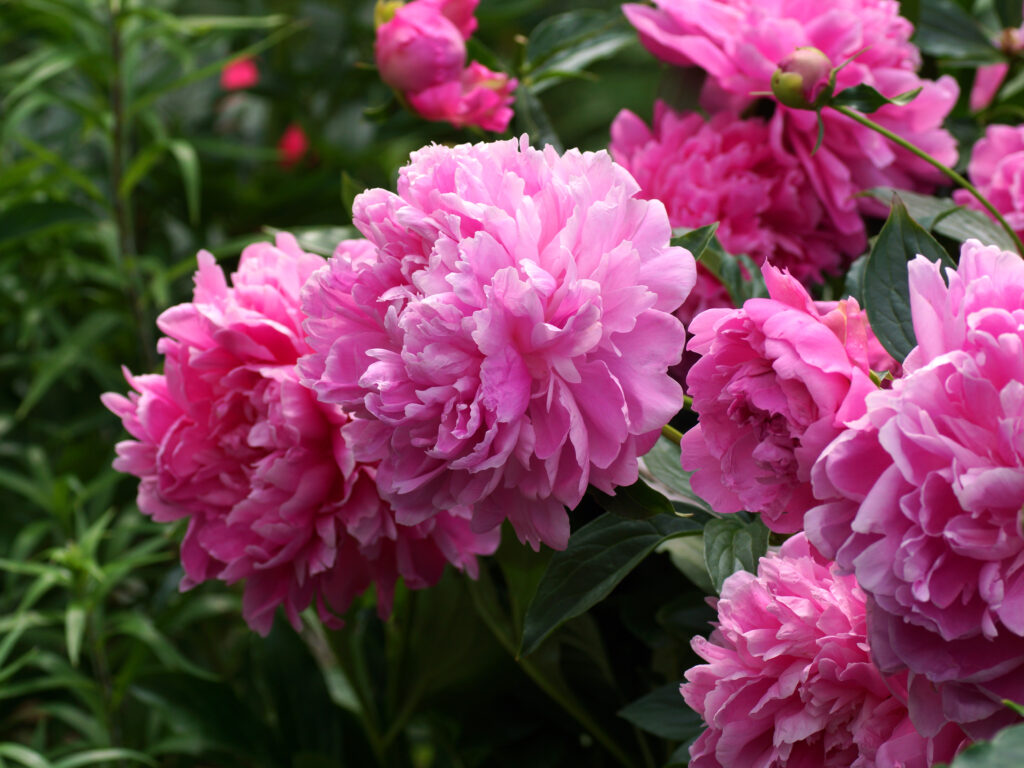
The additional petals of double peonies give them a full, fluffy, and luxuriant look similar to a pom pom.
©Natali22206/Shutterstock.com
Dahlias
Double dahlias, also known as ‘Dahlia Double Pompone,” have a gorgeous ball form that resembles a multicolored pom pom. One of the most widespread cultivars is Dahlia variabilis, which can grow large, up to a 12-inch diameter.
These flowers should receive at least 6 hours of direct sunlight per day. They also need regular watering. Avoid overwatering them, which can cause root rot. They grow best in hardiness zones 8 to 11.
Some pests that can attack double dahlias include slugs, snails, and thrips. These pests can cause damage to the flowers and even spread diseases. Regular monitoring and appropriate control measures, such as insecticidal soaps, can help prevent this.
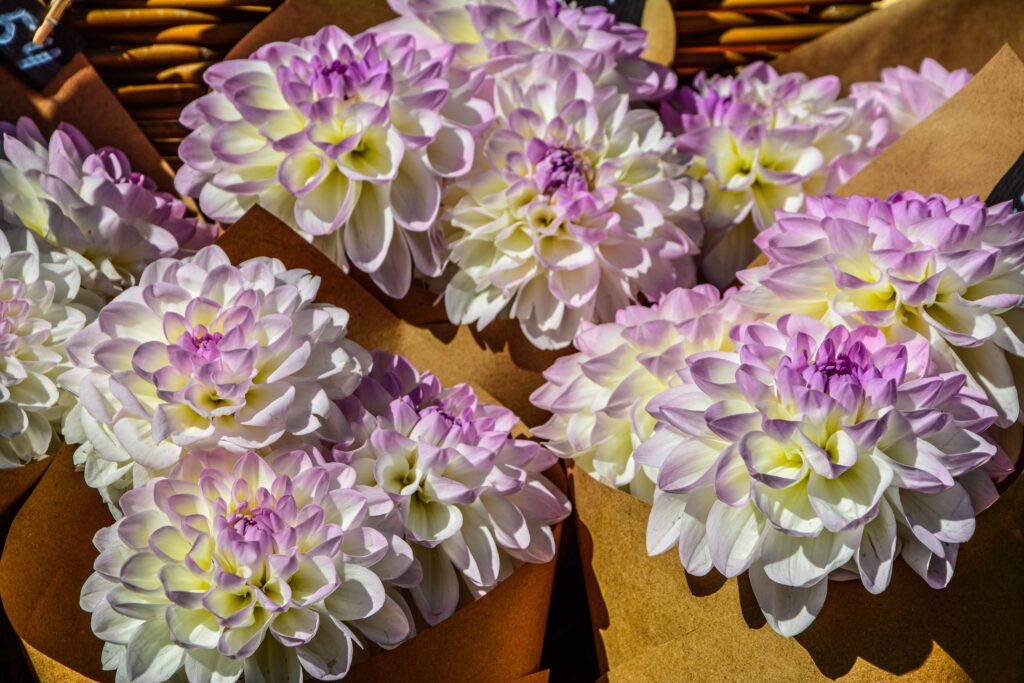
Double dahlias, also known as ‘Dahlia Double Pompone,” have a gorgeous ball form that resembles a multicolored pom pom.
©Weha/Shutterstock.com
Chrysanthemums
Double chrysanthemums (Morifolium) have densely packed spherical blooms. They bloom in the fall and are relatively easy to grow and maintain, and they grow best in hardiness zones 5 to 9.
These stunning flowers thrive in areas with cool temperatures and moderate humidity, as they can suffer in hot and dry conditions. They also benefit from pinching off the top of the plant when it reaches 6 inches tall to encourage bushier growth and more blooms.
Common pests that affect chrysanthemums include aphids, spider mites, and leafhoppers. Monitor your flowers for signs of infestation and treat them with insecticidal soap or neem oil as needed.

These stunning flowers thrive in areas with cool temperatures and moderate humidity, as they can suffer in hot and dry conditions.
©Dorothy Adaha Kayina/Shutterstock.com
Begonias
Double begonias (Begonias Tuberhybrida) are relatively easy to care for and can be grown indoors and outdoors, depending on the climate. They grow best in partial shade or filtered sunlight and should be consistently moist, as they are susceptible to drying.
Generally, double begonias are well-suited to hardiness zones 9 to 11, characterized by mild to warm winters with minimum temperatures.
These small and lovely flowers do best when fertilized regularly. Some common pests that may attack them include mealybugs, thrips, and aphids. These pests can cause damage to the leaves and flowers of the plant.
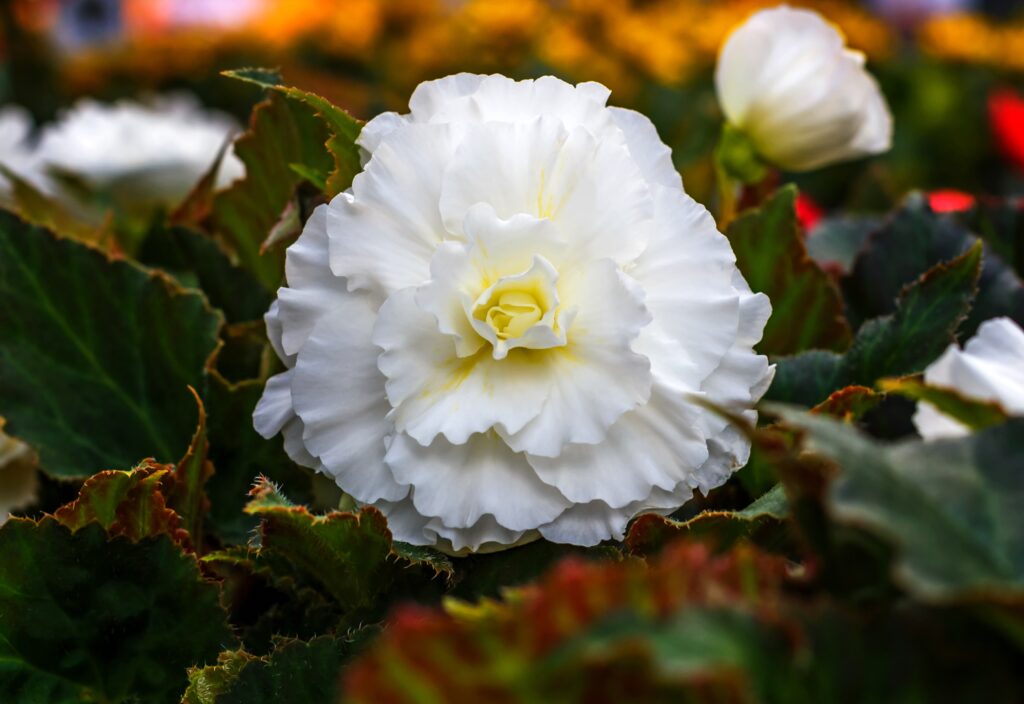
Double begonias are relatively easy to care for and can be grown indoors and outdoors, depending on the climate.
©Nnattalli/Shutterstock.com
Carnations
Double carnations (Dianthus caryophyllus), known as “clove pinks,” are popular flowers with intricate, layered blooms. Carnations are known to thrive in USDA hardiness zones 6 to 9.
Double carnations prefer well-draining soil and full sun to partial shade. They require regular watering, especially during dry periods. Deadheading spent blooms can help promote continued blooming.
Depending on the specific variety and growing conditions, these flowers typically bloom in late spring to early summer. And, with proper care, they can continue to bloom intermittently throughout the summer and into the fall.
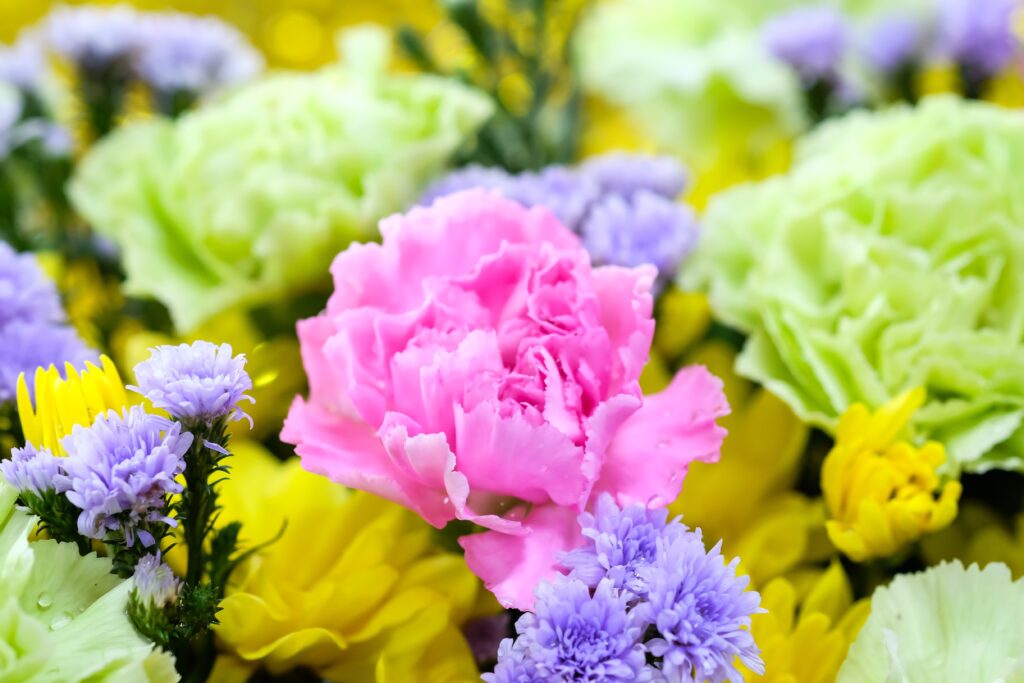
Double carnations, known as “clove pinks,” are popular flowers with intricate, layered blooms.
©Alis Magic of Photos/Shutterstock.com
Daisies
Double daisies (Bellis perennial) are a type of daisies that produce large, showy flowers with double or semi-double petals. These flowers are typically white or pink and bloom in the late spring or early summer.
Growing double daisies is relatively easy and can thrive in many growing conditions. They prefer full sun and well-draining soil that is kept moist but never waterlogged. Most double daisies prefer to grow in hardiness zones 4 to 8.
Even though they are relatively low-maintenance, they can be susceptible to a few common pests and diseases. Aphids, spider mites, and thrips can infest these plants.

Growing double daisies is relatively easy and can thrive in many growing conditions.
©M9K/Shutterstock.com
An uncommon but stunning type of flower
Growing double flowers can be a rewarding experience, but it requires a little extra care and attention compared to growing single flowers. However, with suitable soil, sunlight, water, and nutrients, you can enjoy a stunning display of blooms in your garden.
Whether you’re a seasoned flower enthusiast or just starting to explore the gardening world, double flowers are an excellent addition to any collection. Their lush and full blooms impress and delight, bringing color and beauty to any space they occupy.
Check gardening magazines, nurseries, or your neighborhood supply store, if you’re looking for double-bloom flowers.
The photo featured at the top of this post is © Nnattalli/Shutterstock.com
FAQs (Frequently Asked Questions)
How are double-bloom flowers produced?
Double bloom flowers can arise by selective breeding and hybridization procedures, some of which include:
- One approach is to cross-pollinate plants with the double blossom characteristic from several species or types. There’s a good chance this will produce a double blossom.
- They can be created from mutation breeding, which involves subjecting plants to chemicals or radiation to cause mutations.
- It is possible to promote the growth of additional petals by using “petal multiplication” techniques that involve pinching, cutting, or bending flower buds.
- It is possible to encourage the creation of additional petals by modifying plant hormones and growth regulators in charge of petal development.
Why do people dislike double-bloom flowers?
Some people in the gardening community find the full, rounded shape and ruffled flowers overly frilly and unnatural. They prefer simpler single-flower flowers.
But, the biggest argument against them is that they don’t produce nectar or pollen, which makes it impossible to attract bees and other pollinators.
What are semi-double flowers?
Semi-double flowers refer to flowers that have slightly more petals than a typical single flower but not as many petals as a fully double flower. The petals give the flower a fuller appearance than a single flower.
Semi-double flowers contain two or more layers of petals, but the center of the flower is still open. In contrast to double flowers, which have several petals developing around and covering the stamen.
Some examples of flowers that commonly produce semi-double blooms include roses, dahlias, and camellias.
Semi-double flowers have blooms with an intermediate number of petals between a single and double flower. They are similar to double flowers, but instead of having numerous layers of petals, they have only one or two additional rows of petals around the central disk of the flower.
Semi-double flowers are prized for their unique appearance and are often used in floral arrangements and as cut flowers. They come in various colors and are available in many flowers, including roses, peonies, camellias, dahlias, and many more.
Growing semi-double flowers requires similar care to cultivating other types of flowers. They prefer well-drained soil and a sunny location but can also tolerate partial shade. Consistent watering and fertilization can help promote healthy growth and more blooms.
Semi-double flowers are a beautiful and unique addition to any garden or floral arrangement. Their intermediate petal structure offers an attractive compromise between single and double flowers, making them popular among flower enthusiasts.
Thank you for reading! Have some feedback for us? Contact the AZ Animals editorial team.







